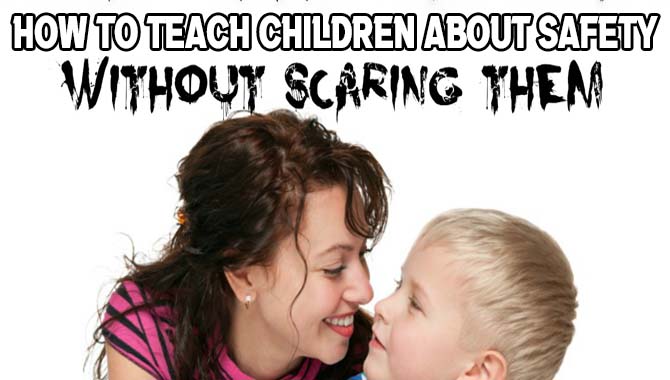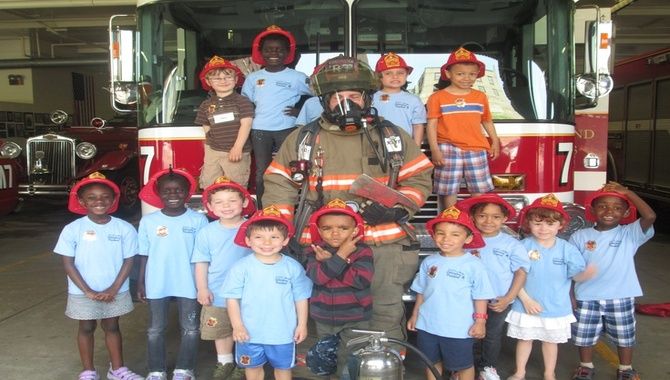Today, so many dangers are lurking in the world that it can be hard to keep children safe. From online threats to physical dangers, knowing what to do to ensure your kids are safe can be hard.
As parents, we want our children to be safe. But sometimes, it’s tough to talk about safety without scaring them. We want them to be aware of the danger but not be afraid to go outside and play. That’s why it’s important to find a way to discuss safety without being terrifying.
We’ll outline some ways to do just that. We’ll discuss topics like stranger danger, dangers in the home, and more, whether you’re looking for tips on raising safety-conscious kids or want to read something that makes you feel better.

5 Steps To Teaching Children About Safety Without Scaring Them
When teaching your children about safety, there are a few key things you need to keep in mind. It can be difficult to teach children about safety without scaring them. But by following these five simple steps, you can ensure that they learn the importance of safety in a fun and engaging way.
1. Start By Talking About Safety In General

It’s important to start by discussing safety in broad terms. Talk about the dangers that can occur anywhere, no matter what time of year. This will help your children become aware of the dangers and prepare them more for whatever mischief they might get up to. It’ll also give you a chance to answer any questions they have about danger zones and what they should do if something bad happens.
2. Share Real-Life Stories Of Dangerous Occurrences

Stories are an excellent way to teach children about safety without scaring them. Show them examples of real-life dangers that children have faced and explain what the child could have done to avoid these situations. This will help your kids learn how to be smart about safety and give you a chance to talk about the importance of being observant.
3. Explain Stranger Danger

Stranger danger is one of the most important topics when teaching children about safety. Not only do they need to be aware of dangers in their everyday lives, but they should also be aware of potential threats posed by people they don’t know well – or at all. To ensure your child’s safety, discuss stranger danger in detail and explain the dangers of not knowing who someone is.
4. Talk About Dangers In The Home

One of the most common hazards that children face is abuse or neglect inside their homes. When discussing safety around the home, be sure to include discussions about abusive behavior and what kids can do if they witness this type of situation. This will help them understand how important it is to get involved if they see something wrong – even if it might scare them a little bit at first.
5. Teach Children About Fire Safety

Fire is one of the most dangerous things a child can encounter, and it’s important to teach them about all the different types of fires and how to prevent them from happening in the first place. Talk about keeping things clean (both inside and outside your home) and having an escape plan if there’s ever a fire in progress. This way, you’ll be ensuring that your child is as prepared as possible for whatever dangers life might bring their way.
Tips For Teaching Children About Safety
It’s important to teach your children about safety early so they know how to stay safe in their everyday lives and when they’re out and about. Here are a few tips for teaching them about safety:
– Always use common sense when it comes to choosing what your child can and can’t do
– Explain the dangers of strangers, unfamiliar places, and dangerous activities
– Make sure your child knows where the emergency numbers locate and how to use them
– Keep a close eye on your child at all times, even when they’re playing outside
– Never leave your child unattended in a car or any other place where they may be unsafe
Conclusion
It’s important to teach your children about safety early so they know how to stay safe in their everyday lives and when they’re out and about. Make sure that you provide them with an overview of the dangers that exist around them. This will help them to be more aware of their surroundings and be conscious of potential risks.
Teaching children about safety is an important part of parenting, but it can be challenging to do so in a way that isn’t scary. By following these five simple steps, you can help your children learn about safety in a way that won’t scare them. Plus, these tips will help you keep your children safe while you’re out and about.
Frequently Asked Questions
1.What Are Some Guidelines For Teaching Children About Safety Online?
Ans: As parents, we are responsible for teaching our children about online safety in an age-appropriate way. It is important to start teaching your child the importance of not sharing personal information online at a young age.
Explain that people they encounter online may not always be who they say they are, and it is always best to come to you if they feel unsafe or uncomfortable with anything online. Make sure to have regular conversations with your child about their online activities and monitor their digital footprint.
2.How Can I Ensure My Child Uses Safe Online Tools And Platforms?
Ans: You must discuss online safety with your child, emphasizing the potential risks and dangers. Set age restrictions for different online platforms, so your child is not exposed to unsuitable content or messages. Additionally, monitor your child’s digital activities to ensure they are not engaging in risky behaviors. If you observe inappropriate content or messages, talk to your child about what to do safely and securely.
3.What Should I Do If My Child Has Been Viewing Inappropriate Content Online?
Ans: If you’ve discovered that your child has been viewing inappropriate content online, it’s important to remain calm. Remember, children are often curious about the world and what’s happening around them. Instead of overreacting, talk to your child about why it’s inappropriate for them to view this kind of content.
You may also want to explain the risks of accessing such content, such as viruses or identity theft. Finally, if the inappropriate content continues to be viewed even after you’ve tried to talk to your child and put parental controls in place, consider talking to a professional.
4.How Can I Raise A Confident, Savvy, And Safe Child When Interacting With The Internet?
Ans: There are a few things that you can do to help raise a child who is confident, savvy, and safe when interacting with the internet.
- Start by teaching your child about online safety from a young age. Explain the concept of stranger danger and discuss how to handle unwanted contact. Address their questions and concerns respectfully and maturely.
- Set boundaries for internet use and encourage open dialogue about their online experiences. Let them know what is allowed and what isn’t, and ensure they understand why certain rules are implemented.
- Monitor their social media activity, and remind them to keep personal information private. If they ever feel uncomfortable or unsafe online, let them know immediately and take appropriate measures.
5.Is It Okay To Talk To My Child About Sex Education In An Age-Appropriate Way?
Ans: Yes, it is important to talk to your child about sex education in an age-appropriate way. What does this mean for you as a parent? Start by teaching your child about personal safety and setting boundaries. Ensure they know how to identify abuse and not be afraid to tell you if they feel uncomfortable or unsafe.
Talk to them about the concept of consent. Explain that everyone needs permission before sexual activities can take place. Teach them how to recognize signs of abuse and when to get help.

Leave a Reply